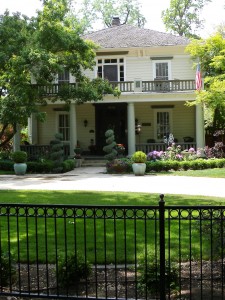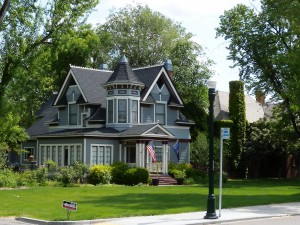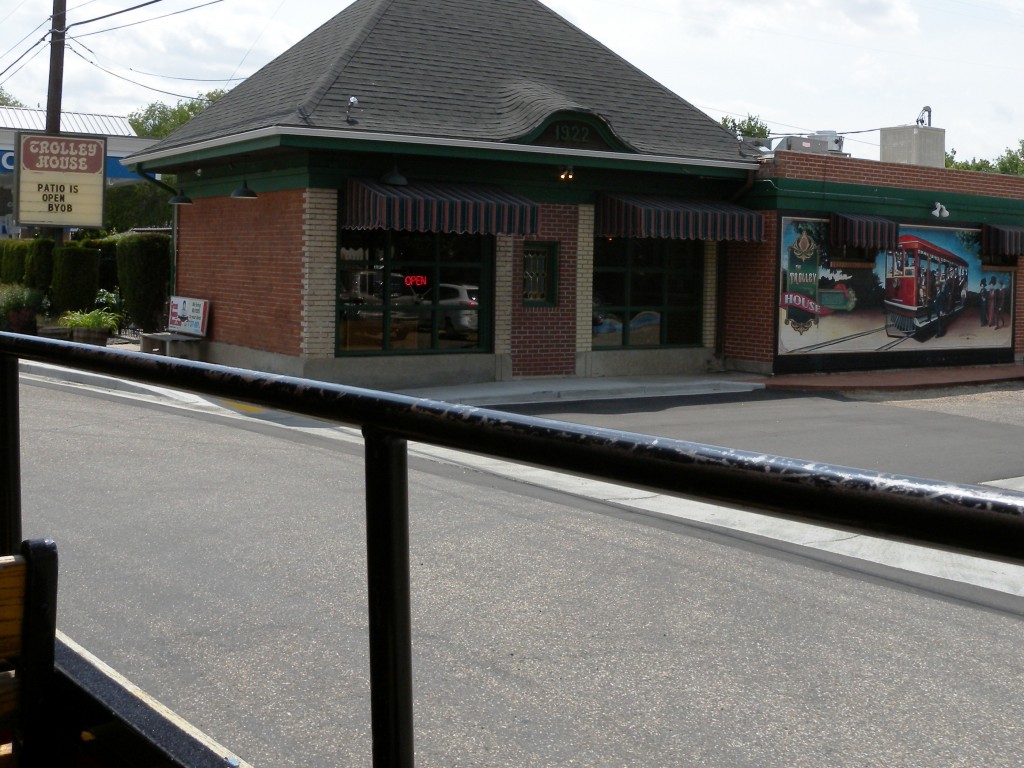» posted on Monday, May 21st, 2012 by Linda Lou Burton
Some Like It Hot
 Linda Burton posting from Boise, Idaho – The Trolley stopped so we could see the carriage step, a charming bit of history that remains on Warm Springs Avenue. Our Tour Guide told us stories of the stately houses that we passed; the first bathtub in this one; the first dishwasher in that one; the geothermal heat in all. There’s a new house on the corner where the Natatorium once stood, it was a warm-water pool, geothermal heat. As we passed the capitol on our Trolley ride, it was mentioned once again – the only capitol in the United States with geothermal heat. So where, I asked, is this hot water? I’ve been to Yellowstone; I’ve seen the geysers and the steaming bubbling pools, favored spots for buffalo in winter snows. I’ve been to Hot Springs National Park; I’ve seen the bathhouses there, favored spots for people seeking soothing waters to ease their aches and pains. Magic waters, underground, where are they in Idaho, and how do people harness them? They come “right from Hades,” printed the Idaho Statesman in December 1890, referring to an artesian well just drilled west of Table Rock.
Linda Burton posting from Boise, Idaho – The Trolley stopped so we could see the carriage step, a charming bit of history that remains on Warm Springs Avenue. Our Tour Guide told us stories of the stately houses that we passed; the first bathtub in this one; the first dishwasher in that one; the geothermal heat in all. There’s a new house on the corner where the Natatorium once stood, it was a warm-water pool, geothermal heat. As we passed the capitol on our Trolley ride, it was mentioned once again – the only capitol in the United States with geothermal heat. So where, I asked, is this hot water? I’ve been to Yellowstone; I’ve seen the geysers and the steaming bubbling pools, favored spots for buffalo in winter snows. I’ve been to Hot Springs National Park; I’ve seen the bathhouses there, favored spots for people seeking soothing waters to ease their aches and pains. Magic waters, underground, where are they in Idaho, and how do people harness them? They come “right from Hades,” printed the Idaho Statesman in December 1890, referring to an artesian well just drilled west of Table Rock.
 The 1890’s were exciting times for Boise. Idaho had just become the 43rd state, and people were optimistic about the city’s future. John Paulsen was hired by Boise’s Artesian Hot & Cold Water Company to design a natatorium with a pool using water from that well; modeled after a fancy-Moorish-style that had been built in Helena, Montana. But the plans were for more than pleasurable use of the area’s geothermal gifts. Petroglyphs on rocks showed that Native Americans used hot water springs for warmth many, many years ago; it was known that pioneers, miners, and traders in the 1800’s used them too. Banker C W Moore, president of the water company, took a bold step; he installed hot water heating in his home, a new brick mansion at the corner of Warm Springs Avenue and Walnut Street. His was the first house in America to be heated in this way.
The 1890’s were exciting times for Boise. Idaho had just become the 43rd state, and people were optimistic about the city’s future. John Paulsen was hired by Boise’s Artesian Hot & Cold Water Company to design a natatorium with a pool using water from that well; modeled after a fancy-Moorish-style that had been built in Helena, Montana. But the plans were for more than pleasurable use of the area’s geothermal gifts. Petroglyphs on rocks showed that Native Americans used hot water springs for warmth many, many years ago; it was known that pioneers, miners, and traders in the 1800’s used them too. Banker C W Moore, president of the water company, took a bold step; he installed hot water heating in his home, a new brick mansion at the corner of Warm Springs Avenue and Walnut Street. His was the first house in America to be heated in this way.
 An electric street car ran from downtown to the new Natatorium and Warm Springs Avenue was the scene of more building than any other part of the city. Houses, and businesses, with geothermal heat. The idea spread to downtown. The October 4, 1892 Idaho Statesman noted “The decision to bring the hot water into town for heating purposes is one of the most important steps recently taken here. There is enough…to heat the entire city….It will make Boise…the most desirable and livable city in the west.”
An electric street car ran from downtown to the new Natatorium and Warm Springs Avenue was the scene of more building than any other part of the city. Houses, and businesses, with geothermal heat. The idea spread to downtown. The October 4, 1892 Idaho Statesman noted “The decision to bring the hot water into town for heating purposes is one of the most important steps recently taken here. There is enough…to heat the entire city….It will make Boise…the most desirable and livable city in the west.”
Fast forward a hundred years.
 In the early 1980s the State of Idaho drilled two wells in the vicinity of the Capitol Building; Well #1 goes down 2,150 feet; Well # 2 is 3,030 feet deep. By 1982, the State of Idaho geothermal system was supplying heat from 165-degree-Fahrenheit water to nine buildings in the Capitol Mall complex, including the State Capitol. It’s true, Idaho has the only state capitol in the US that is heated by geothermal water.
In the early 1980s the State of Idaho drilled two wells in the vicinity of the Capitol Building; Well #1 goes down 2,150 feet; Well # 2 is 3,030 feet deep. By 1982, the State of Idaho geothermal system was supplying heat from 165-degree-Fahrenheit water to nine buildings in the Capitol Mall complex, including the State Capitol. It’s true, Idaho has the only state capitol in the US that is heated by geothermal water.
In 1981 four wells were drilled northeast of downtown Boise and along the edge of the Boise Front Foothills. Uses for geothermal heat spread to greenhouses and fish farms (imagine, raising alligators in Idaho!). But all this activity caused some water management problems and declining water levels brought about restrictions on thermal development.
In the mid-1990s, a computer modeling study for the Boise geothermal system predicted how water levels and water temperatures might be affected by different production and injection scenarios. In 1999 the City of Boise began re-injecting their used geothermal water into the aquifer through a newly completed injection well. Since then, water levels in nearby wells have risen significantly. Today there are hundreds of geothermal wells and springs not being used for thermal applications; many have temperatures ideal for direct use application such as aquaculture, greenhouses, recreation, and food drying; some have higher temperatures that are suitable for power generation.
Currently, four independent heating districts operate geothermal systems within Boise. The Boise Public Works Department operates the system that serves the downtown core area. The State of Idaho operates the system that heats the Idaho State Capitol and several other buildings within the Capitol Mall area. The Veterans Administration provides service to the VA campus, and the Boise Warm Springs Water District provides service to the residential properties in the vicinity of Warm Springs Avenue, where it all began.
 Take a trip down Warm Springs Avenue on the Boise Trolley Tour, see the sights and hear the facts of Boise history. Call 208-433-0849 or make reservations online. http://www.americanheritagetrolleytours.com/
Take a trip down Warm Springs Avenue on the Boise Trolley Tour, see the sights and hear the facts of Boise history. Call 208-433-0849 or make reservations online. http://www.americanheritagetrolleytours.com/
Read the history of Idaho Energy Resources
